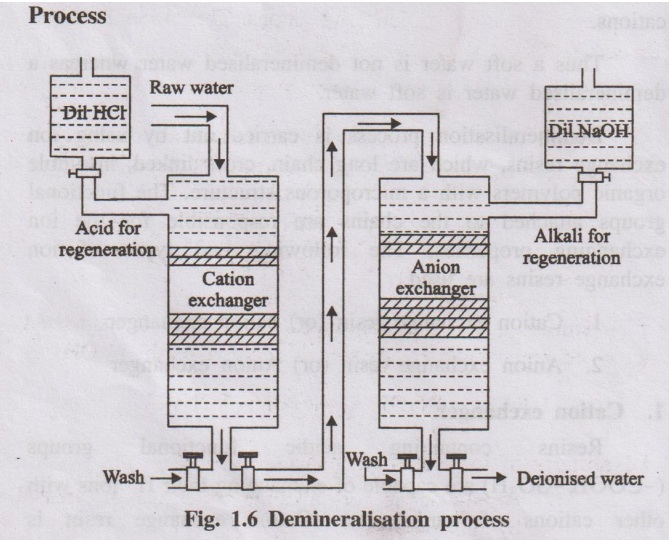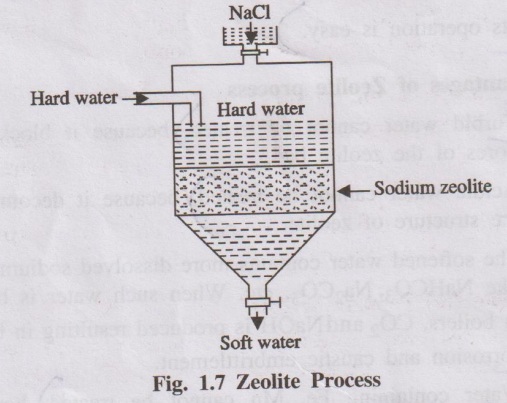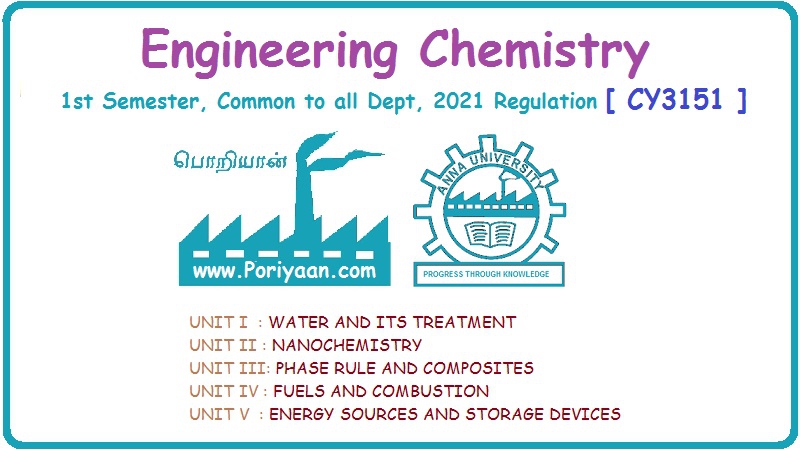Engineering Chemistry: Unit I: Water and its Treatment
Treatment of Boiler Feed Water (Softening or Conditioning Methods)
The process of removing hardness producing salts from water is known as softening (or) conditioning of water.
TREATMENT OF BOILER
FEED WATER (SOFTENING OR CONDITIONING METHODS)
Water used for industrial purposes
should be free from hardness producing substances, suspended impurities and
dissolved gases etc. The process of removing hardness producing salts from water is
known as softening (or) conditioning of water.
Softening of water can be done in two methods
1. Internal treatment.
2. External treatment.
1. Internal Conditioning (or) Internal Treatment (or) Boiler Compounds
It involves the removal of scale forming
substance, which were not completely removed in the external treatment, by
adding chemicals directly into the boiler. This chemicals are also called
boiler compounds.
1. Phosphate
conditioning
Scale formation can be avoided by adding sodium phosphate. It is
used in high pressure boilers. The phosphate reacts with Ca2+ and Mg2+
salts to give soft sludges of
calcium and magnesium phosphates.
3 CaSO4 + 2 Na3PO4 → Ca3(PO4)2
+ 3Na2SO4
Generally 3 types of phosphates are employed.
(a) Trisodium phosphate - Na3PO4
(Too alkaline) - used for too acidic water.
(b) Disodium hydrogen phosphate - Na2HPO4 (weakly alkaline) - used for
weakly acidic water.
(c) Sodium dihydrogen
phosphate - NaH2PO4
(acidic) - used for alkaline water.
2. Colloidal conditioning
Scale formation can be avoided by adding colloidal conditioning
agents like kerosene, agar-agar, gelatin, etc., It is used in low pressure
boilers. These colloidal substances get coated over the scale forming particles
and convert them into non-adherent, loose precipitate called sludge, which can
be removed by blow down operation.
3. Sodium aluminate conditioning
Sodium aluminate (NaA1O2) under goes hydrolysis in
boiler water to give gelatinous white precipitate of aluminium hydroxide and
sodium hydroxide.
NaA1O2 + 2H2O → Al(OH)3 + NaOH
The sodium hydroxide, thus formed, precipitates magnesium as
magnesium hydroxide. The gelatinous precipitates of aluminium hydroxide and magnesium
hydroxide entrap the colloidal silica and finely divided solids and settled
easily. This can be removed easily by blow down operations.
4. Calgon conditioning
Calgon is sodium hexa meta phosphate Na2 [Na4(PO3)6].
This substance interacts with calcium ions forming a highly soluble complex and
thus prevents the precipitation of scale forming salt.
2 CaSO4 + Na2[Na4(PO3)6]
→ Na2[Ca2(PO3)6] + 2 Na2SO4.
The complex Na2 [Ca2(PO3)6] is
soluble in water and there is no problem of sludge disposal. So calgon
conditioning is better than phosphate conditioning.
2. External conditioning (or) External Treatment
It involves the removal of hardness producing salts from the water
before feeding into the boiler. The external treatment can be done by two
process
1. Demineralisation (or) Ion-exchange process
2. Zeolite process.
1. lon Exchange (or) Demineralisation process
This process removes almost all the ions (both anions and cations)
present in hard water.
The soft water, produced by zeolite
processes, does not contain hardness producing Ca2+ and Mg2+
ions, but it contains other ions like Na+, K+, SO2-4,
Cl- etc., On the other hand D.M. (Demineralised)
water does not
contain both anions and cations.
Thus a soft water is not demineralised water whereas a
demineralised water is soft water.
Demineralisation process is carried out by using ion exchange
resins, which are long chain, cross linked, insoluble organic polymers with a
microporous structure. The functional groups attached to the chains are
responsible for the ion exchanging properties. The following two types of ion
exchange resins are used.
1. Cation exchange resin (or) cation exchanger
2. Anion exchange resin (or) Anion exchanger
1. Cation exchanger
Resins containing acidic functional groups (-COOH -SO3H)
are capable of exchanging their H+ ions with other cations of hard
water. Cation exchange resin is represented as RH2.
Examples
(i) Sulphonated coals.
(ii) Sulphonated
polystyrene.
R - SO3H ; R-COOH ≡ RH2
2. Anion Exchanger
Resins containing basic functional groups (-NH2, -OH)
are capable of exchanging their anions with other anions of hard water. Anion
exchange resin is represented as R (OH)2.
Examples
(i) Cross-linked
quaternary ammonium salts.
(ii) Urea-formaldehyde
resin.
R - NR3OH ; R-OH; R-NH2
≡ R(OH)2
Process

The hard water first passed through a cation exchange column,
(Fig. 1.6) which absorbs all the cations like Ca2+, Mg2+,
Na+, K+, etc., present in the hard water.
RH2 + CaCl2 → RCa + 2HCl
RH2 + MgSO4 → RMg + H2SO4
RH + NaCl → RNa + HCl
The cation free water is then passed through a anion exchange
column, which absorbs all the anions like Cl-, SO2-4, HCO-3,
etc., present in the water.
R'(OH)2 + 2HC1 → R'Cl2 + 2H2O
R'(OH)2 + H2SO4 → R'SO4 + 2H2O
The water coming out of the anion exchanger is completely free
from cations and anions. This water is known as demineralised water (or)
deionised water.
Regeneration
When the cation exchange resin is exhausted, it can be regenerated
by passing a solution of dil HCl (or) dil H2SO4.
RCa + 2HCl → RH2 +CaCl2
RNa + HCI → RH + NaCl
Similarly, when the anion exchange resin is exhausted, it can be
regenerated by passing a solution of dil NaOH.
R'Cl2 + 2NaOH → R'(OH)2 + 2NaCl.
Advantages of
ion-exchange process
(i) Highly acidic (or) alkaline water can be treated by this
process.
(ii) The water obtained by
this process will have very low hardness (nearly 2. ppm).
Disadvantages of
ion-exchange process
(i) Water containing turbidity, Fe and Mn cannot be treated,
because turbidity reduces the output and Fe, Mn form stable compound with the
resin.
(ii) The equipment is costly and more expensive chemicals are
needed.
2. Zeolite (or)
Permutit process
Zeolites are naturally occurring hydrated sodium aluminosilicate.
Its general formula is Na2O. Al2O3 . xSiO2
.yH2O. (x = 2 – 10, y = 2 – 6) . Natural zeolites are green sand and
non-porous. The synthetic form of zeolite is known as permutit, which is porous
and possess gel like structure, hence it is generally used for water softening.
Synthetic zeolite is represented by Na2Ze. The sodium
ions which are loosely held in Na2Ze are replaced by Ca2+
and Mg2+ ions present in the water.
Process
When hard water is passed through a bed of sodium zeolite (Na2Ze),
kept in a cylinder (Fig. 1.7), it exchanges its sodium ions with Ca2+ and
Mg2+ ions present in the hard water to form calcium and magnesium
zeolites. The various reactions taking place during softening process are
Ca(HCO3)2 + Na2Ze → CaZe + 2NaHCO3
Mg(HCO3) 2 + Na2Ze → MgZe +
2NaHCO3
CaSO4 + Na2Ze → CaZe + Na2SO4
MgSO4 + Na2Ze → MgZe + Na2SO4

CaCl2 + Na2Ze → CaZe + 2NaCl
MgCl2 + Na2Ze → MgZe + 2NaCl
The softened water is enriched with large amount of sodium salts,
which do not cause any hardness, but cannot be used in boilers.
Regeneration
After some time zeolite gets exhausted. The exhausted zeolite is
again regenerated by treating with 10% solution of NaCl.
CaZe + 2NaCl → Na2Ze + CaCl2
MgZe + 2NaCl → Na2Ze + MgCl2
Advantages of Zeolite process
(i) Water obtained by this process will have only hardness of 1-2
ppm.
(ii) This method is cheap, because the regenerated zeolite can be
used again.
(iii) No sludge is formed during this process
(iv) The equipment used is compact and occupies a small space.
(v) Its operation is easy.
Disadvantages of Zeolite process
(i) Turbid water cannot be treated, because it blocks the pores of
the zeolite bed.
(ii) Acidic water cannot be treated, because it decomposes the
structure of zeolite.
(iii) The softened water contains more dissolved sodium salts
like NaHCO3, Na2CO3, etc. When
such water is boiled in boilers, CO2 and NaOH is produced resulting
in boiler corrosion and caustic embrittlement.
(iv) Water containing Fe, Mn cannot be treated because regeneration
is very difficult.
(v) This process cannot be used for softening brackish water, because
brackish water contains Na+ ions. So the ion exchange reaction will
not occur.
Table 1.2 Differences
between Zeolite and Demineralisation process
Zeolite Process
1. It exchanges only cations.
2. Acidic water cannot be treated because acid decomposes the
zeolite.
3. The treated water contains relatively large amount of dissolved
salts, which leads to priming, foaming and caustic embrittlement in boilers.
4. Water containing turbidity, Fe, Mn cannot be treated.
Demineralisation
Process
1. It exchanges cations as well as anions.
2. Acidic water can be treated.
3. The treated does not contain any dissolved salts. Hence there
is no priming and foaming.
4. Here also water containing turbidity, Fe, Mn cannot be treated.
Engineering Chemistry: Unit I: Water and its Treatment : Tag: Engineering Chemistry : - Treatment of Boiler Feed Water (Softening or Conditioning Methods)
Related Topics
Related Subjects
Engineering Chemistry
CY3151 1st Semester | 2021 Regulation | 1st Semester Common to all Dept 2021 Regulation
